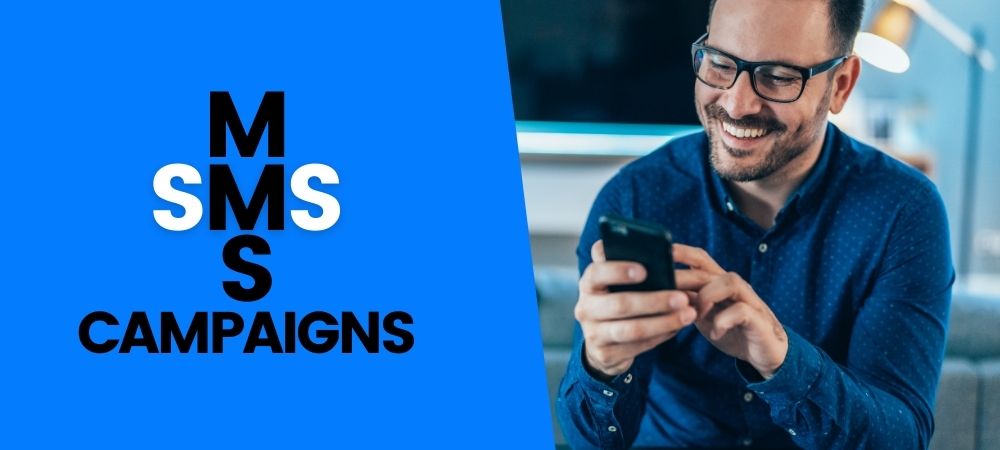College texting campaigns are a powerful way to reach—and influence—Generation Z, or anybody. Used strategically, SMS (short message service) and MMS (multimedia messaging service) campaigns can build strong relationships with prospects—and help drive enrollment.
Read on for an overview of college texting campaigns and how to employ SMS and MMS to achieve your enrollment goals.
What is a college texting campaign?
A text messaging campaign is a group of SMS and/or MMS messages focused on a single topic, generally sent within the span of a few minutes. Compared to email or calls, college texting is rapid and real-time.
College texting campaigns tend to fall into one of three categories:
- Nudges and reminders
- Brand and cultural
- Data collection
Depending on the objective, schools may focus on a single category—but employing a mixture of all three is typically most effective in driving enrollment.
Why use college texting?
College texting is by far the most popular—and effective—way to reach Generation Z, a cohort that constitutes most of today’s college prospects. As “digital natives,” Gen Z prefers rapid, convenient, and personalized communication.

Mainstay (formerly AdmitHub) reports a nearly 100% open rate for texts sent to students. In comparison, only 58% of Gen Z report checking email more than once a day, with an average open rate of just under 20%.
College texting can also benefit staff, helping streamline communication and save valuable administrative time. Potential benefits include:
- Reduced volume of emails and calls
- Reduced need for task reminders, such as application deadlines
- Deeper insight into student concerns and needs
SMS vs. MMS
You can employ SMS (short message service), MMS (multimedia messaging service), or a mixture of both for texting campaigns. SMS is:
- Text based
- Limited to 160 characters
- Great for nudges, reminders and data collection campaigns
MMS is especially effective for brand and cultural texting campaigns, as multimedia messages use more illustrative and dynamic content. MMS content includes:
- GIFS
- Videos
- Audio recordings
- Images
As visual-based content, MMS achieves a 15% higher click through rate than SMS—and is 4x as likely to be shared on social media. MMS also accommodates more content, with a 5,000 character limit and a 64-character headline.
Drive your campaign strategy
When crafting a college texting campaign, define goals and desired outcomes first. Chart enrollment-driven goals to help drive your campaign strategy.
Mainstay identifies four key college texting goals:
- Collect data on prospects
- Inspire prospects to action
- Personalize content
- Position school as trusted resource
Consider aligning messages with each stage of the admissions funnel, from prospect to enrolled. An integrated approach ensures effective lead nurturing and increases personalization by addressing student needs at specific points in time.
Achieve your enrollment goals
How can college texting campaigns help achieve your enrollment goals? Below, we outline Mainstay’s three campaign categories and how each can help reach your goals.
EXAMPLE:
Nudges and reminders
Signal Vine defines nudging as “coaxing or gently encouraging (someone) to do something.” In higher education, nudges and reminders can drive action by relaying specific, time-sensitive tasks.
Text campaigns might focus on:
- Deadlines, including application, scholarship, and housing
- Events, like information sessions or orientation
- Admissions and application resources
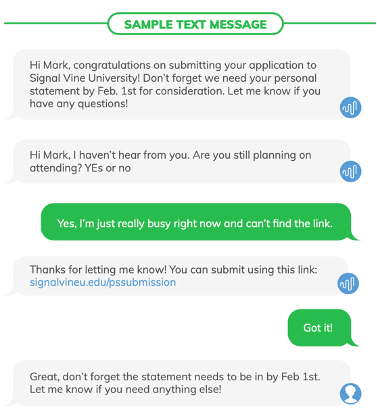
Signal Vine’s sample application deadline campaign helps inspire action by communicating specific deadlines. SVU positions the school as a resource by providing a submission link and offering to answer any questions. Content is tailored to students in the applicant stage.

Leo University uses a GIF via MMS to “nudge” admitted students toward submitting a FAFSA. The GIF preemptively answers the question “What is FAFSA?” and showcases students applying.
EXAMPLE:
Cultural and brand messages
College texting brand campaigns can capture your school’s ethos by showcasing character and feel. Brand texts help build excitement and community—two enrollment-boosting strategies.
A college texting brand campaign might center on:
- Student and alumni success stories
- School fun facts and trivia
- Campus clubs, sports, and arts groups
Consider using MMS to help bring your brand to life. Videos and images capture brand more fully than written text, offering immersion into the student experience.
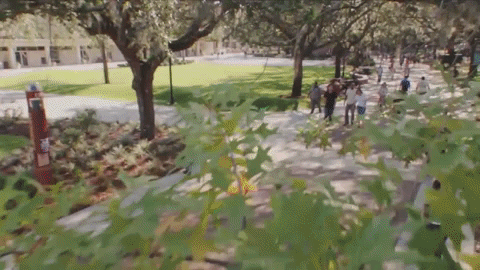
Florida State University provides a short campus overview via GIF, spotlighting current students commuting to and from class.
Other possible MMS content could include:
- Short video tours of residence halls
- Images from key events, such as graduation or sporting events
- GIFs which illustrate brand personality (friendly, humorous)
EXAMPLE:
Data collection
College texting is a valuable tool for mining prospect data. Consider disseminating surveys and polls via text to investigate prospective student interests, needs, and concerns.
Campaign themes might center on:
- Preferences and challenges
- Feedback on events
- Likelihood to apply and/or enroll
- Demographics and background
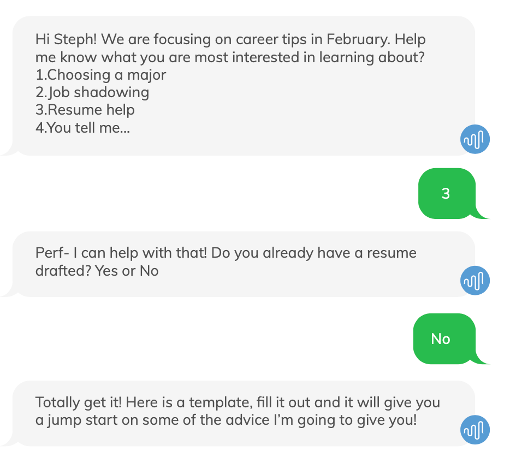
Signal Vine’s career tips campaign focuses on career interests. SVU polls prospective and current students on career interests, which can inform future programs. The school follows up with career resources.
Data can also help develop and hone student personas. Use demographic information to fine-tune personas and drive future messaging strategy.
Bring your campaigns to life
A distinctive voice and tone help portray brand personality. Carefully consider how you want texts perceived—and what approach will motivate prospects.
Mainstay offers several best writing practices for college texting:
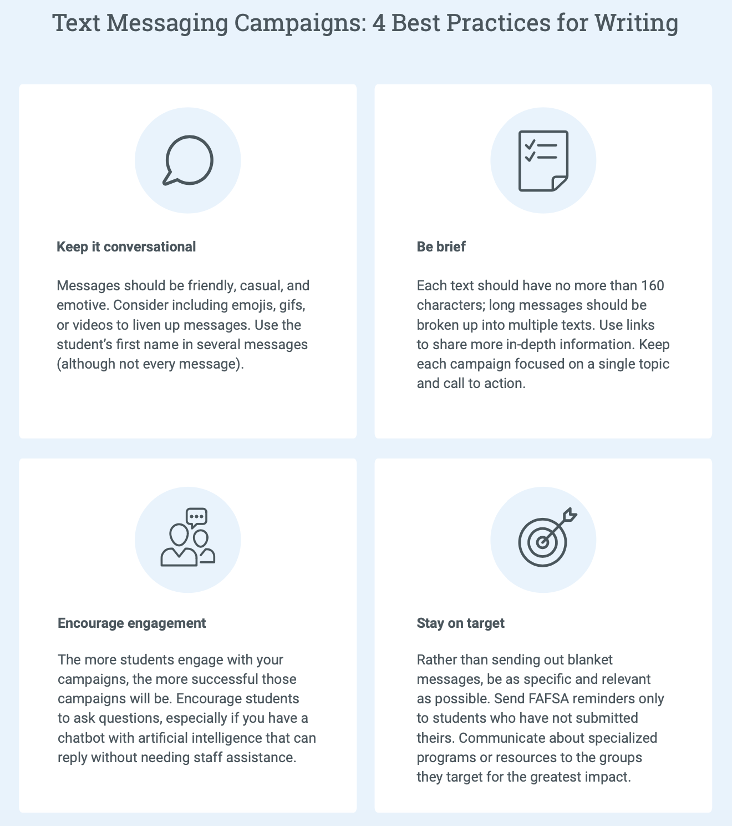
Our companion piece, How to Nurture Leads with College Texting, offers several additional writing tips:
- Make taking action easy
Include links and direct contact information. - Include specific calls to action
Highlight deadlines and explicit next steps. - Offer supplemental information
Cross-market different engagement opportunities.
Employ marketing automation
If possible, use marketing automation software to help manage college texting campaigns. Marketing automation sends communication triggered by specific actions, helping hone strategy and streamline processes.
Marketing automation can also improve message personalization and track campaign ROI—essential tools for elevating enrollment.
At LeadSquared, our automation software offers a slew of additional benefits:
- Integration with other channels, like email and social media
- Lead segmentation for targeted communication
- Data collection to optimize performance
Learn more about using the power of marketing automation with LeadSquared.
Expand your college texting program
After solidifying enrollment-focused text campaigns, consider using text campaigns to pursue other goals. College texting can also engage alumni, raise money, and help retain current students.
Engage alumni
Before graduation, establish a regular cadence of communication via text with alumni. Help bridge your relationship from student to alumni by offering information on alumni benefits.
For working alumni, campaigns can provide opportunities for continued engagement and helpful professional resources.
Consider campaigns focused on:
- Alumni benefits, like continued career services
- Alumni events
- Mentorship opportunities
- Key school announcements and updates
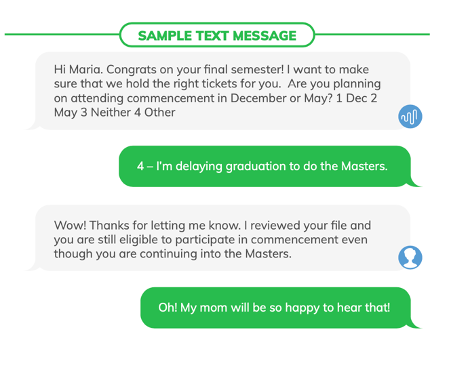
Signal Vine’s sample text engages new alumni to gauge graduation plans. SVU provides helpful resources and helps bridge communication from student to alumni.
Advance fundraising goals
College texting is also an effective fundraising tool. Texting campaigns can support annual drives, or solicit donations for special, program-specific causes.
Consider targeting a variety of audiences, including:
- Alumni
- Parents of current students
- Past volunteers
Depending on campaign type, content might include:
- Videos of campus programs
- Links to donation pages
- Thank you messages from students
- Details on gift impact
Improve student retention
Student retention is a continued challenge for college admissions. A coordinated texting campaign can redirect student concerns and address issues.
Consider using retention campaigns to:
- Check in on students during the semester
- Identify students who need extra help
- Direct students to resources and opportunities
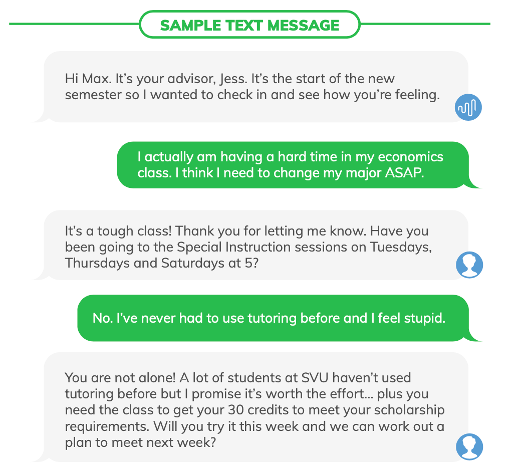
Signal Vine checks in with current student Max to see how he’s doing. SVU offers academic support options and resources to help Max with his economics class.
College texting is a key marketing tool for reaching prospects and students alike. SMS and MMS campaigns can help nurture student relationships, proactively addressing questions, concerns, and needs. Used effectively, college texting campaigns can help build lasting relationships—and elevate enrollment.





